PRM6001 Project Management & Risk: Hospitality Equipment Project
VerifiedAdded on 2023/06/10
|16
|5447
|299
Project
AI Summary
This project management and risk assessment report focuses on the procurement and implementation of hospitality equipment, specifically an electrical patient lift. It identifies the project as a manufacturing project involving procurement from a non-listed supplier. The report details the rationale behind the project, highlighting its benefits for patient care. It addresses the triple constraint of time, cost, and scope, outlining the project life cycle's five stages: initiation, planning, execution, monitoring and controlling, and closure. Various project methodologies, including Waterfall, Six Sigma, and Critical Path Method, are discussed, along with tools like Work Breakdown Structure (WBS) and Gantt charts. The report also includes a risk assessment, identifying potential hazards and recommending appropriate contract types. Furthermore, it considers the structure and management of the project team to ensure successful implementation. Desklib provides access to this project and many other solved assignments to help students with their studies.

Project management
and risk
and risk
Paraphrase This Document
Need a fresh take? Get an instant paraphrase of this document with our AI Paraphraser
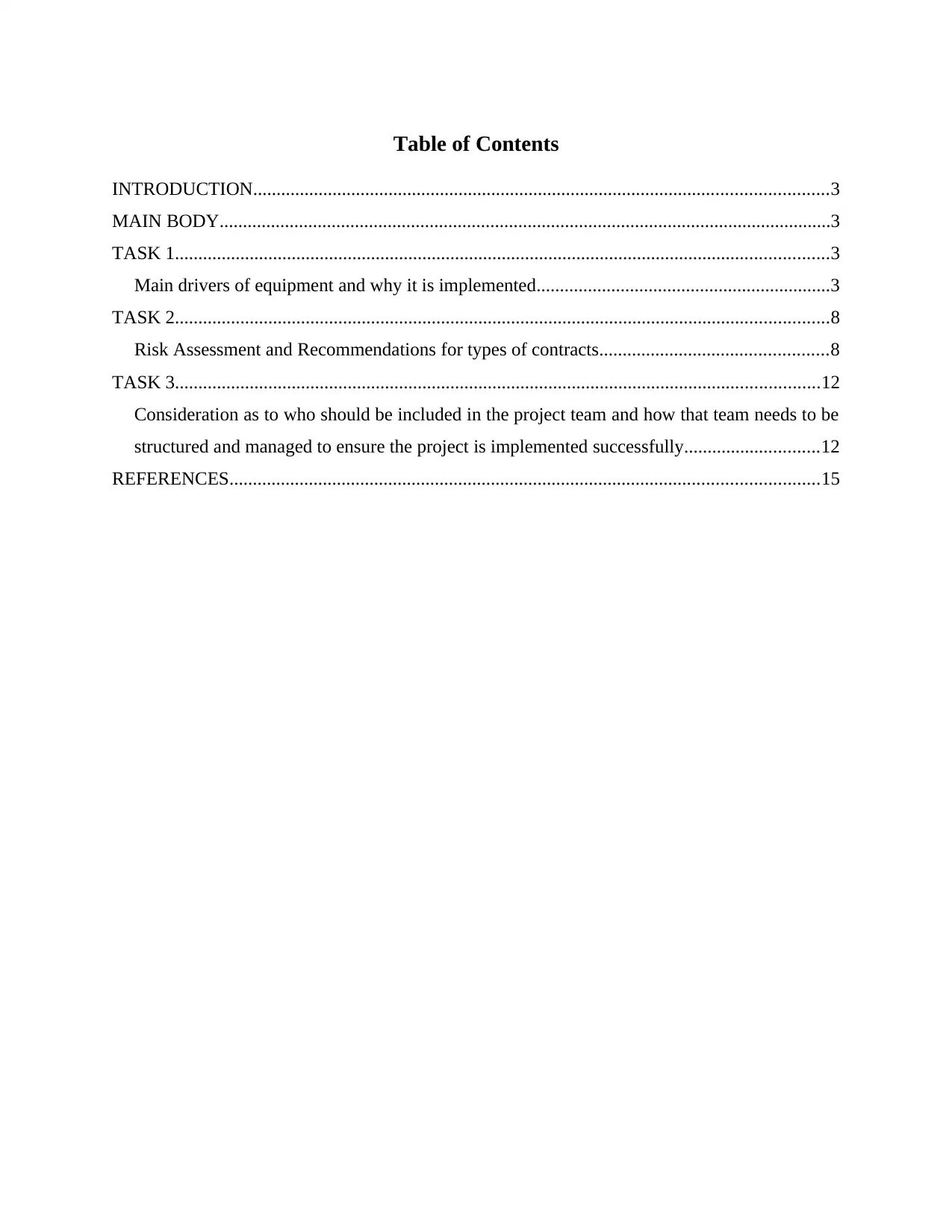
Table of Contents
INTRODUCTION...........................................................................................................................3
MAIN BODY...................................................................................................................................3
TASK 1............................................................................................................................................3
Main drivers of equipment and why it is implemented...............................................................3
TASK 2............................................................................................................................................8
Risk Assessment and Recommendations for types of contracts.................................................8
TASK 3..........................................................................................................................................12
Consideration as to who should be included in the project team and how that team needs to be
structured and managed to ensure the project is implemented successfully.............................12
REFERENCES..............................................................................................................................15
INTRODUCTION...........................................................................................................................3
MAIN BODY...................................................................................................................................3
TASK 1............................................................................................................................................3
Main drivers of equipment and why it is implemented...............................................................3
TASK 2............................................................................................................................................8
Risk Assessment and Recommendations for types of contracts.................................................8
TASK 3..........................................................................................................................................12
Consideration as to who should be included in the project team and how that team needs to be
structured and managed to ensure the project is implemented successfully.............................12
REFERENCES..............................................................................................................................15
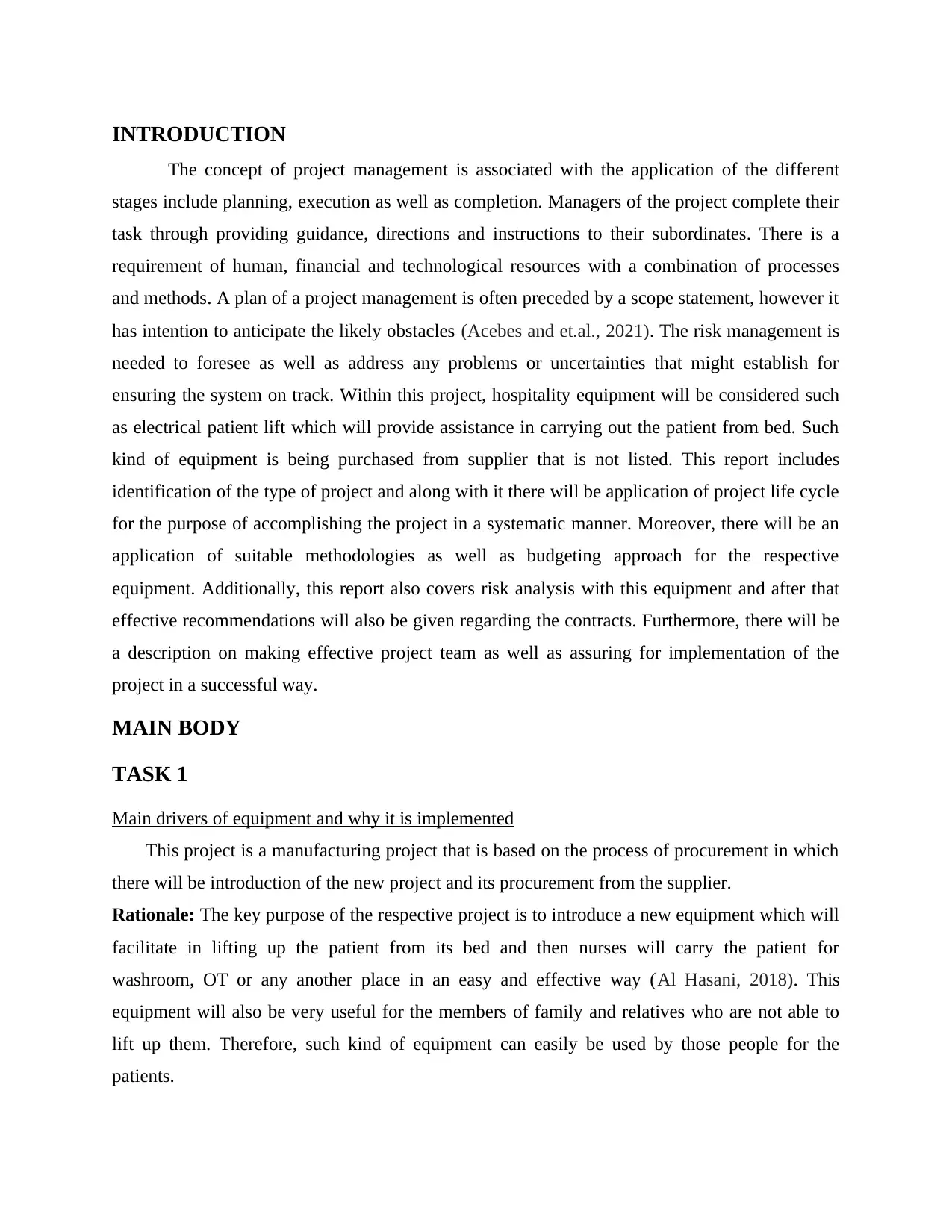
INTRODUCTION
The concept of project management is associated with the application of the different
stages include planning, execution as well as completion. Managers of the project complete their
task through providing guidance, directions and instructions to their subordinates. There is a
requirement of human, financial and technological resources with a combination of processes
and methods. A plan of a project management is often preceded by a scope statement, however it
has intention to anticipate the likely obstacles (Acebes and et.al., 2021). The risk management is
needed to foresee as well as address any problems or uncertainties that might establish for
ensuring the system on track. Within this project, hospitality equipment will be considered such
as electrical patient lift which will provide assistance in carrying out the patient from bed. Such
kind of equipment is being purchased from supplier that is not listed. This report includes
identification of the type of project and along with it there will be application of project life cycle
for the purpose of accomplishing the project in a systematic manner. Moreover, there will be an
application of suitable methodologies as well as budgeting approach for the respective
equipment. Additionally, this report also covers risk analysis with this equipment and after that
effective recommendations will also be given regarding the contracts. Furthermore, there will be
a description on making effective project team as well as assuring for implementation of the
project in a successful way.
MAIN BODY
TASK 1
Main drivers of equipment and why it is implemented
This project is a manufacturing project that is based on the process of procurement in which
there will be introduction of the new project and its procurement from the supplier.
Rationale: The key purpose of the respective project is to introduce a new equipment which will
facilitate in lifting up the patient from its bed and then nurses will carry the patient for
washroom, OT or any another place in an easy and effective way (Al Hasani, 2018). This
equipment will also be very useful for the members of family and relatives who are not able to
lift up them. Therefore, such kind of equipment can easily be used by those people for the
patients.
The concept of project management is associated with the application of the different
stages include planning, execution as well as completion. Managers of the project complete their
task through providing guidance, directions and instructions to their subordinates. There is a
requirement of human, financial and technological resources with a combination of processes
and methods. A plan of a project management is often preceded by a scope statement, however it
has intention to anticipate the likely obstacles (Acebes and et.al., 2021). The risk management is
needed to foresee as well as address any problems or uncertainties that might establish for
ensuring the system on track. Within this project, hospitality equipment will be considered such
as electrical patient lift which will provide assistance in carrying out the patient from bed. Such
kind of equipment is being purchased from supplier that is not listed. This report includes
identification of the type of project and along with it there will be application of project life cycle
for the purpose of accomplishing the project in a systematic manner. Moreover, there will be an
application of suitable methodologies as well as budgeting approach for the respective
equipment. Additionally, this report also covers risk analysis with this equipment and after that
effective recommendations will also be given regarding the contracts. Furthermore, there will be
a description on making effective project team as well as assuring for implementation of the
project in a successful way.
MAIN BODY
TASK 1
Main drivers of equipment and why it is implemented
This project is a manufacturing project that is based on the process of procurement in which
there will be introduction of the new project and its procurement from the supplier.
Rationale: The key purpose of the respective project is to introduce a new equipment which will
facilitate in lifting up the patient from its bed and then nurses will carry the patient for
washroom, OT or any another place in an easy and effective way (Al Hasani, 2018). This
equipment will also be very useful for the members of family and relatives who are not able to
lift up them. Therefore, such kind of equipment can easily be used by those people for the
patients.
⊘ This is a preview!⊘
Do you want full access?
Subscribe today to unlock all pages.

Trusted by 1+ million students worldwide
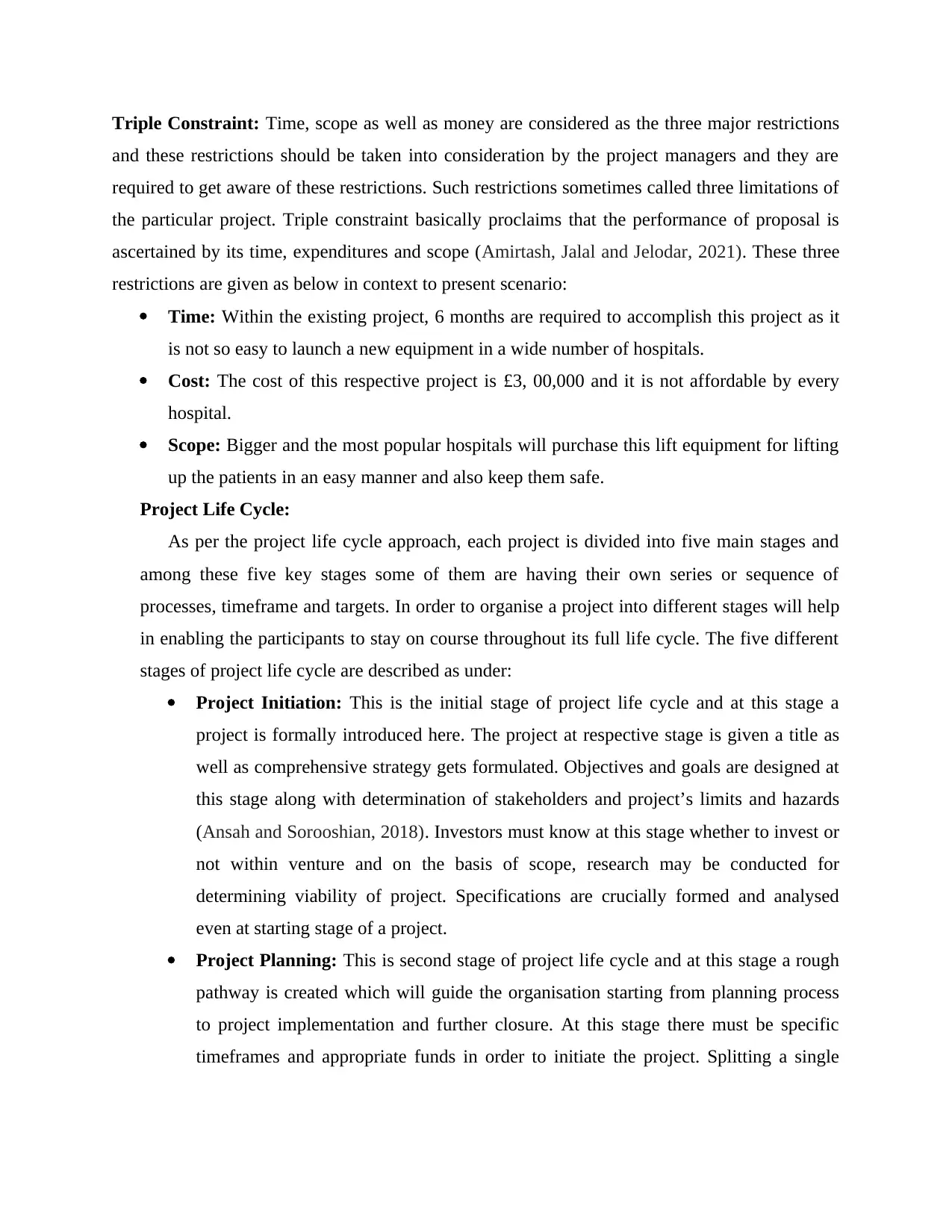
Triple Constraint: Time, scope as well as money are considered as the three major restrictions
and these restrictions should be taken into consideration by the project managers and they are
required to get aware of these restrictions. Such restrictions sometimes called three limitations of
the particular project. Triple constraint basically proclaims that the performance of proposal is
ascertained by its time, expenditures and scope (Amirtash, Jalal and Jelodar, 2021). These three
restrictions are given as below in context to present scenario:
Time: Within the existing project, 6 months are required to accomplish this project as it
is not so easy to launch a new equipment in a wide number of hospitals.
Cost: The cost of this respective project is £3, 00,000 and it is not affordable by every
hospital.
Scope: Bigger and the most popular hospitals will purchase this lift equipment for lifting
up the patients in an easy manner and also keep them safe.
Project Life Cycle:
As per the project life cycle approach, each project is divided into five main stages and
among these five key stages some of them are having their own series or sequence of
processes, timeframe and targets. In order to organise a project into different stages will help
in enabling the participants to stay on course throughout its full life cycle. The five different
stages of project life cycle are described as under:
Project Initiation: This is the initial stage of project life cycle and at this stage a
project is formally introduced here. The project at respective stage is given a title as
well as comprehensive strategy gets formulated. Objectives and goals are designed at
this stage along with determination of stakeholders and project’s limits and hazards
(Ansah and Sorooshian, 2018). Investors must know at this stage whether to invest or
not within venture and on the basis of scope, research may be conducted for
determining viability of project. Specifications are crucially formed and analysed
even at starting stage of a project.
Project Planning: This is second stage of project life cycle and at this stage a rough
pathway is created which will guide the organisation starting from planning process
to project implementation and further closure. At this stage there must be specific
timeframes and appropriate funds in order to initiate the project. Splitting a single
and these restrictions should be taken into consideration by the project managers and they are
required to get aware of these restrictions. Such restrictions sometimes called three limitations of
the particular project. Triple constraint basically proclaims that the performance of proposal is
ascertained by its time, expenditures and scope (Amirtash, Jalal and Jelodar, 2021). These three
restrictions are given as below in context to present scenario:
Time: Within the existing project, 6 months are required to accomplish this project as it
is not so easy to launch a new equipment in a wide number of hospitals.
Cost: The cost of this respective project is £3, 00,000 and it is not affordable by every
hospital.
Scope: Bigger and the most popular hospitals will purchase this lift equipment for lifting
up the patients in an easy manner and also keep them safe.
Project Life Cycle:
As per the project life cycle approach, each project is divided into five main stages and
among these five key stages some of them are having their own series or sequence of
processes, timeframe and targets. In order to organise a project into different stages will help
in enabling the participants to stay on course throughout its full life cycle. The five different
stages of project life cycle are described as under:
Project Initiation: This is the initial stage of project life cycle and at this stage a
project is formally introduced here. The project at respective stage is given a title as
well as comprehensive strategy gets formulated. Objectives and goals are designed at
this stage along with determination of stakeholders and project’s limits and hazards
(Ansah and Sorooshian, 2018). Investors must know at this stage whether to invest or
not within venture and on the basis of scope, research may be conducted for
determining viability of project. Specifications are crucially formed and analysed
even at starting stage of a project.
Project Planning: This is second stage of project life cycle and at this stage a rough
pathway is created which will guide the organisation starting from planning process
to project implementation and further closure. At this stage there must be specific
timeframes and appropriate funds in order to initiate the project. Splitting a single
Paraphrase This Document
Need a fresh take? Get an instant paraphrase of this document with our AI Paraphraser
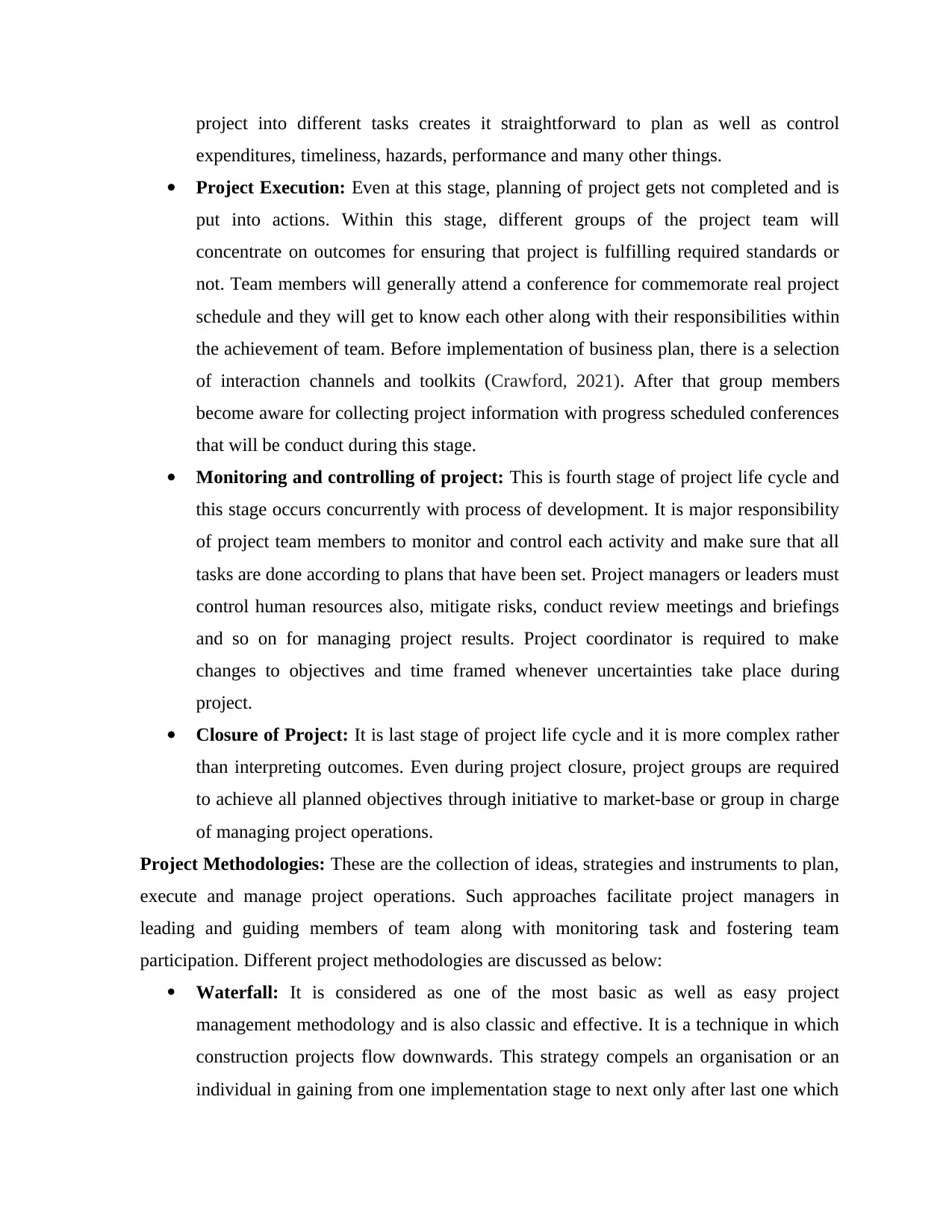
project into different tasks creates it straightforward to plan as well as control
expenditures, timeliness, hazards, performance and many other things.
Project Execution: Even at this stage, planning of project gets not completed and is
put into actions. Within this stage, different groups of the project team will
concentrate on outcomes for ensuring that project is fulfilling required standards or
not. Team members will generally attend a conference for commemorate real project
schedule and they will get to know each other along with their responsibilities within
the achievement of team. Before implementation of business plan, there is a selection
of interaction channels and toolkits (Crawford, 2021). After that group members
become aware for collecting project information with progress scheduled conferences
that will be conduct during this stage.
Monitoring and controlling of project: This is fourth stage of project life cycle and
this stage occurs concurrently with process of development. It is major responsibility
of project team members to monitor and control each activity and make sure that all
tasks are done according to plans that have been set. Project managers or leaders must
control human resources also, mitigate risks, conduct review meetings and briefings
and so on for managing project results. Project coordinator is required to make
changes to objectives and time framed whenever uncertainties take place during
project.
Closure of Project: It is last stage of project life cycle and it is more complex rather
than interpreting outcomes. Even during project closure, project groups are required
to achieve all planned objectives through initiative to market-base or group in charge
of managing project operations.
Project Methodologies: These are the collection of ideas, strategies and instruments to plan,
execute and manage project operations. Such approaches facilitate project managers in
leading and guiding members of team along with monitoring task and fostering team
participation. Different project methodologies are discussed as below:
Waterfall: It is considered as one of the most basic as well as easy project
management methodology and is also classic and effective. It is a technique in which
construction projects flow downwards. This strategy compels an organisation or an
individual in gaining from one implementation stage to next only after last one which
expenditures, timeliness, hazards, performance and many other things.
Project Execution: Even at this stage, planning of project gets not completed and is
put into actions. Within this stage, different groups of the project team will
concentrate on outcomes for ensuring that project is fulfilling required standards or
not. Team members will generally attend a conference for commemorate real project
schedule and they will get to know each other along with their responsibilities within
the achievement of team. Before implementation of business plan, there is a selection
of interaction channels and toolkits (Crawford, 2021). After that group members
become aware for collecting project information with progress scheduled conferences
that will be conduct during this stage.
Monitoring and controlling of project: This is fourth stage of project life cycle and
this stage occurs concurrently with process of development. It is major responsibility
of project team members to monitor and control each activity and make sure that all
tasks are done according to plans that have been set. Project managers or leaders must
control human resources also, mitigate risks, conduct review meetings and briefings
and so on for managing project results. Project coordinator is required to make
changes to objectives and time framed whenever uncertainties take place during
project.
Closure of Project: It is last stage of project life cycle and it is more complex rather
than interpreting outcomes. Even during project closure, project groups are required
to achieve all planned objectives through initiative to market-base or group in charge
of managing project operations.
Project Methodologies: These are the collection of ideas, strategies and instruments to plan,
execute and manage project operations. Such approaches facilitate project managers in
leading and guiding members of team along with monitoring task and fostering team
participation. Different project methodologies are discussed as below:
Waterfall: It is considered as one of the most basic as well as easy project
management methodology and is also classic and effective. It is a technique in which
construction projects flow downwards. This strategy compels an organisation or an
individual in gaining from one implementation stage to next only after last one which
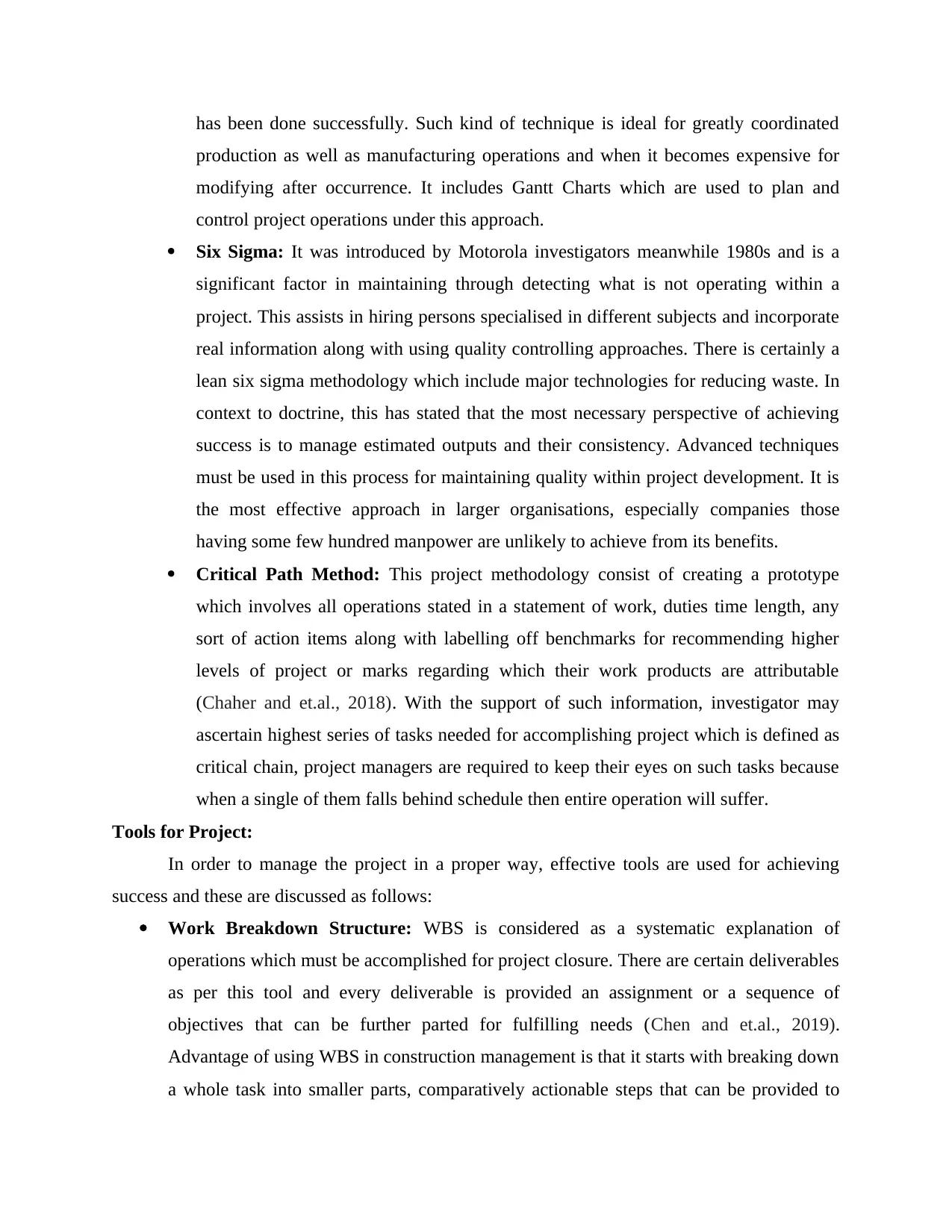
has been done successfully. Such kind of technique is ideal for greatly coordinated
production as well as manufacturing operations and when it becomes expensive for
modifying after occurrence. It includes Gantt Charts which are used to plan and
control project operations under this approach.
Six Sigma: It was introduced by Motorola investigators meanwhile 1980s and is a
significant factor in maintaining through detecting what is not operating within a
project. This assists in hiring persons specialised in different subjects and incorporate
real information along with using quality controlling approaches. There is certainly a
lean six sigma methodology which include major technologies for reducing waste. In
context to doctrine, this has stated that the most necessary perspective of achieving
success is to manage estimated outputs and their consistency. Advanced techniques
must be used in this process for maintaining quality within project development. It is
the most effective approach in larger organisations, especially companies those
having some few hundred manpower are unlikely to achieve from its benefits.
Critical Path Method: This project methodology consist of creating a prototype
which involves all operations stated in a statement of work, duties time length, any
sort of action items along with labelling off benchmarks for recommending higher
levels of project or marks regarding which their work products are attributable
(Chaher and et.al., 2018). With the support of such information, investigator may
ascertain highest series of tasks needed for accomplishing project which is defined as
critical chain, project managers are required to keep their eyes on such tasks because
when a single of them falls behind schedule then entire operation will suffer.
Tools for Project:
In order to manage the project in a proper way, effective tools are used for achieving
success and these are discussed as follows:
Work Breakdown Structure: WBS is considered as a systematic explanation of
operations which must be accomplished for project closure. There are certain deliverables
as per this tool and every deliverable is provided an assignment or a sequence of
objectives that can be further parted for fulfilling needs (Chen and et.al., 2019).
Advantage of using WBS in construction management is that it starts with breaking down
a whole task into smaller parts, comparatively actionable steps that can be provided to
production as well as manufacturing operations and when it becomes expensive for
modifying after occurrence. It includes Gantt Charts which are used to plan and
control project operations under this approach.
Six Sigma: It was introduced by Motorola investigators meanwhile 1980s and is a
significant factor in maintaining through detecting what is not operating within a
project. This assists in hiring persons specialised in different subjects and incorporate
real information along with using quality controlling approaches. There is certainly a
lean six sigma methodology which include major technologies for reducing waste. In
context to doctrine, this has stated that the most necessary perspective of achieving
success is to manage estimated outputs and their consistency. Advanced techniques
must be used in this process for maintaining quality within project development. It is
the most effective approach in larger organisations, especially companies those
having some few hundred manpower are unlikely to achieve from its benefits.
Critical Path Method: This project methodology consist of creating a prototype
which involves all operations stated in a statement of work, duties time length, any
sort of action items along with labelling off benchmarks for recommending higher
levels of project or marks regarding which their work products are attributable
(Chaher and et.al., 2018). With the support of such information, investigator may
ascertain highest series of tasks needed for accomplishing project which is defined as
critical chain, project managers are required to keep their eyes on such tasks because
when a single of them falls behind schedule then entire operation will suffer.
Tools for Project:
In order to manage the project in a proper way, effective tools are used for achieving
success and these are discussed as follows:
Work Breakdown Structure: WBS is considered as a systematic explanation of
operations which must be accomplished for project closure. There are certain deliverables
as per this tool and every deliverable is provided an assignment or a sequence of
objectives that can be further parted for fulfilling needs (Chen and et.al., 2019).
Advantage of using WBS in construction management is that it starts with breaking down
a whole task into smaller parts, comparatively actionable steps that can be provided to
⊘ This is a preview!⊘
Do you want full access?
Subscribe today to unlock all pages.

Trusted by 1+ million students worldwide
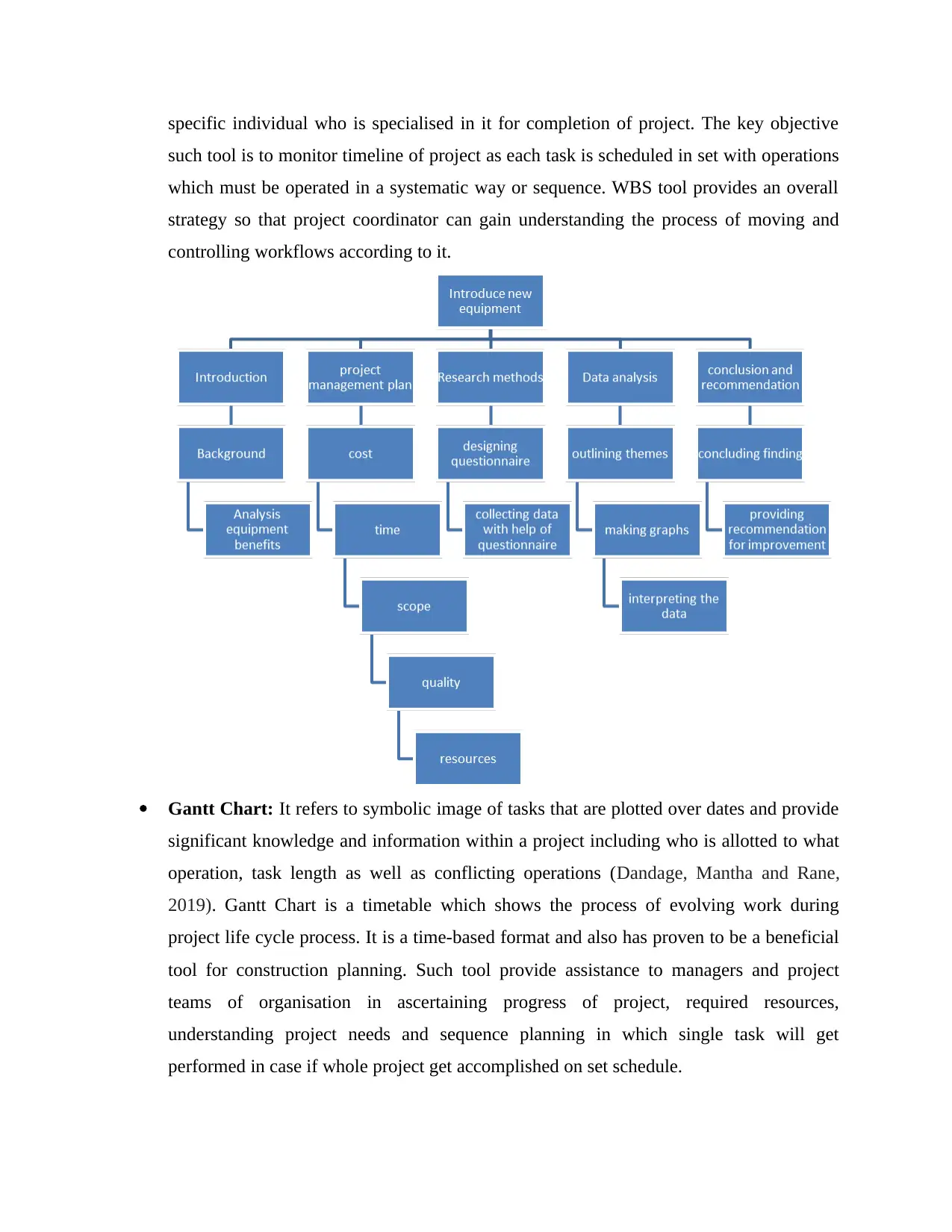
specific individual who is specialised in it for completion of project. The key objective
such tool is to monitor timeline of project as each task is scheduled in set with operations
which must be operated in a systematic way or sequence. WBS tool provides an overall
strategy so that project coordinator can gain understanding the process of moving and
controlling workflows according to it.
Gantt Chart: It refers to symbolic image of tasks that are plotted over dates and provide
significant knowledge and information within a project including who is allotted to what
operation, task length as well as conflicting operations (Dandage, Mantha and Rane,
2019). Gantt Chart is a timetable which shows the process of evolving work during
project life cycle process. It is a time-based format and also has proven to be a beneficial
tool for construction planning. Such tool provide assistance to managers and project
teams of organisation in ascertaining progress of project, required resources,
understanding project needs and sequence planning in which single task will get
performed in case if whole project get accomplished on set schedule.
such tool is to monitor timeline of project as each task is scheduled in set with operations
which must be operated in a systematic way or sequence. WBS tool provides an overall
strategy so that project coordinator can gain understanding the process of moving and
controlling workflows according to it.
Gantt Chart: It refers to symbolic image of tasks that are plotted over dates and provide
significant knowledge and information within a project including who is allotted to what
operation, task length as well as conflicting operations (Dandage, Mantha and Rane,
2019). Gantt Chart is a timetable which shows the process of evolving work during
project life cycle process. It is a time-based format and also has proven to be a beneficial
tool for construction planning. Such tool provide assistance to managers and project
teams of organisation in ascertaining progress of project, required resources,
understanding project needs and sequence planning in which single task will get
performed in case if whole project get accomplished on set schedule.
Paraphrase This Document
Need a fresh take? Get an instant paraphrase of this document with our AI Paraphraser

TASK 2
Risk Assessment and Recommendations for types of contracts
Project Deliverables: Outputs such as planning, progress reports and even meeting reports are
included in this. On other hand, product deliverables may consist of technology, equipment,
agreements, smartphones or even certification factor. The market share demand products and
services at accomplishment of project but there is also a documentation that is mentioned earlier.
When project gets completed, such records are deliverable which are required by the customers
for the purpose of ascertaining scope and accomplishment of construction. Deliverables of
manufacturing project include Agreement Agenda, Project Scheduling, Expenditure Reports and
Evaluation which has founded that illustrates the nature of project operations.
Stages of Risk Assessment: The stages within the risk assessment are little simple and easy
(Demirkaya, 2022). Organisations occasionally prepare a risk assessment which can help it in
detecting hazards which could be injured and also describes the risk management technique
which might stop a happening. All such are typical to an effective as well as efficient evaluation
of risk. Stages of risk assessment are given as below:
Risk identification: This stage states evaluation of organisational culture and seeking for
prospective welfare and health hazards. They can offer an overall image of risks that are
available by consulting with manpower as well as working class people, equipment
maker, customers along with analysing previous safety and health risk evaluations.
Deciding who might be harmed: It must be ensured that people are involved in work
space should be familiar with basic hazards. All employees, clients, customers and
managers as well as even average people must make sure that risk assessments within
organisation are available to all human resources in an easy way.
Completion of risk assessment plan: The paperwork sometimes considered as a major
issue and therefore managers of organisation must look out for SafeWorkPro’s services
for evaluating the risks (Eldridge, 2018). This will also help in gaining the understanding
regarding appropriate risk assessment methodology.
Risk assessment review and update: The development of risk gets fluctuate as the task
progresses. In order to remain compliance with OHS legislations as well as requirements,
their building assessment report should also fluctuate. This helps in conducting proactive
Risk Assessment and Recommendations for types of contracts
Project Deliverables: Outputs such as planning, progress reports and even meeting reports are
included in this. On other hand, product deliverables may consist of technology, equipment,
agreements, smartphones or even certification factor. The market share demand products and
services at accomplishment of project but there is also a documentation that is mentioned earlier.
When project gets completed, such records are deliverable which are required by the customers
for the purpose of ascertaining scope and accomplishment of construction. Deliverables of
manufacturing project include Agreement Agenda, Project Scheduling, Expenditure Reports and
Evaluation which has founded that illustrates the nature of project operations.
Stages of Risk Assessment: The stages within the risk assessment are little simple and easy
(Demirkaya, 2022). Organisations occasionally prepare a risk assessment which can help it in
detecting hazards which could be injured and also describes the risk management technique
which might stop a happening. All such are typical to an effective as well as efficient evaluation
of risk. Stages of risk assessment are given as below:
Risk identification: This stage states evaluation of organisational culture and seeking for
prospective welfare and health hazards. They can offer an overall image of risks that are
available by consulting with manpower as well as working class people, equipment
maker, customers along with analysing previous safety and health risk evaluations.
Deciding who might be harmed: It must be ensured that people are involved in work
space should be familiar with basic hazards. All employees, clients, customers and
managers as well as even average people must make sure that risk assessments within
organisation are available to all human resources in an easy way.
Completion of risk assessment plan: The paperwork sometimes considered as a major
issue and therefore managers of organisation must look out for SafeWorkPro’s services
for evaluating the risks (Eldridge, 2018). This will also help in gaining the understanding
regarding appropriate risk assessment methodology.
Risk assessment review and update: The development of risk gets fluctuate as the task
progresses. In order to remain compliance with OHS legislations as well as requirements,
their building assessment report should also fluctuate. This helps in conducting proactive
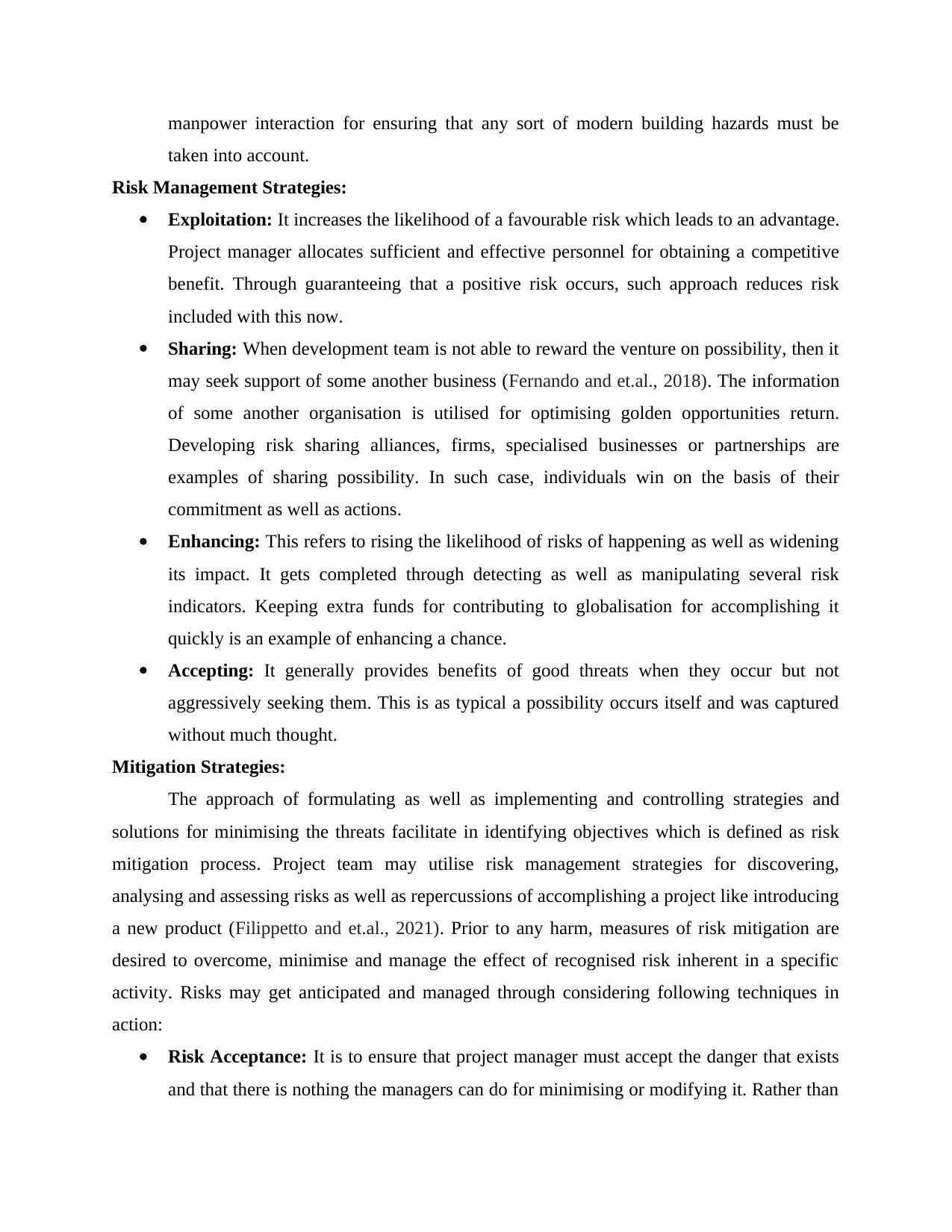
manpower interaction for ensuring that any sort of modern building hazards must be
taken into account.
Risk Management Strategies:
Exploitation: It increases the likelihood of a favourable risk which leads to an advantage.
Project manager allocates sufficient and effective personnel for obtaining a competitive
benefit. Through guaranteeing that a positive risk occurs, such approach reduces risk
included with this now.
Sharing: When development team is not able to reward the venture on possibility, then it
may seek support of some another business (Fernando and et.al., 2018). The information
of some another organisation is utilised for optimising golden opportunities return.
Developing risk sharing alliances, firms, specialised businesses or partnerships are
examples of sharing possibility. In such case, individuals win on the basis of their
commitment as well as actions.
Enhancing: This refers to rising the likelihood of risks of happening as well as widening
its impact. It gets completed through detecting as well as manipulating several risk
indicators. Keeping extra funds for contributing to globalisation for accomplishing it
quickly is an example of enhancing a chance.
Accepting: It generally provides benefits of good threats when they occur but not
aggressively seeking them. This is as typical a possibility occurs itself and was captured
without much thought.
Mitigation Strategies:
The approach of formulating as well as implementing and controlling strategies and
solutions for minimising the threats facilitate in identifying objectives which is defined as risk
mitigation process. Project team may utilise risk management strategies for discovering,
analysing and assessing risks as well as repercussions of accomplishing a project like introducing
a new product (Filippetto and et.al., 2021). Prior to any harm, measures of risk mitigation are
desired to overcome, minimise and manage the effect of recognised risk inherent in a specific
activity. Risks may get anticipated and managed through considering following techniques in
action:
Risk Acceptance: It is to ensure that project manager must accept the danger that exists
and that there is nothing the managers can do for minimising or modifying it. Rather than
taken into account.
Risk Management Strategies:
Exploitation: It increases the likelihood of a favourable risk which leads to an advantage.
Project manager allocates sufficient and effective personnel for obtaining a competitive
benefit. Through guaranteeing that a positive risk occurs, such approach reduces risk
included with this now.
Sharing: When development team is not able to reward the venture on possibility, then it
may seek support of some another business (Fernando and et.al., 2018). The information
of some another organisation is utilised for optimising golden opportunities return.
Developing risk sharing alliances, firms, specialised businesses or partnerships are
examples of sharing possibility. In such case, individuals win on the basis of their
commitment as well as actions.
Enhancing: This refers to rising the likelihood of risks of happening as well as widening
its impact. It gets completed through detecting as well as manipulating several risk
indicators. Keeping extra funds for contributing to globalisation for accomplishing it
quickly is an example of enhancing a chance.
Accepting: It generally provides benefits of good threats when they occur but not
aggressively seeking them. This is as typical a possibility occurs itself and was captured
without much thought.
Mitigation Strategies:
The approach of formulating as well as implementing and controlling strategies and
solutions for minimising the threats facilitate in identifying objectives which is defined as risk
mitigation process. Project team may utilise risk management strategies for discovering,
analysing and assessing risks as well as repercussions of accomplishing a project like introducing
a new product (Filippetto and et.al., 2021). Prior to any harm, measures of risk mitigation are
desired to overcome, minimise and manage the effect of recognised risk inherent in a specific
activity. Risks may get anticipated and managed through considering following techniques in
action:
Risk Acceptance: It is to ensure that project manager must accept the danger that exists
and that there is nothing the managers can do for minimising or modifying it. Rather than
⊘ This is a preview!⊘
Do you want full access?
Subscribe today to unlock all pages.

Trusted by 1+ million students worldwide

this, it also identifies the likelihood of its happening as well as accepting the
repercussions which may rise. It is an optimal approach when hazard is low or is unlikely
to ever occur. When the cost of reducing and risk avoidance is more in comparison to the
cost of just encompassing it as well as leaving it to the luck, it needs taking it.
Risk Avoidance: In case if risk of starting a project, introducing a product or transferring
a firm is very high to bear then in that case it may be wiser for avoiding it (Filippetto,
Lima and Barbosa, 2021). In such scenario, risk avoidance states the refraining from
involving within risky action. Such kind of approach to risk management is most
identical to how individuals interact with particular threats. Although some people are
more hazardous than others, each has a typical threshold beyond which actions become
so dangerous to undertake.
Risk Mitigation: Whenever risks are assessed, specific hazards are better avoided or
accepted. In such case, risk minimisation is researched (Frederico, 2021). The processes
as well as techniques of the risk control are defined as risk mitigation. Whenever they
access risks as well as its likelihood, the organisation may deploy the systems and
resources.
Risk Reduction: Organisations can assign a threshold of the threats appetite which is
known as residue riskiness. The most prevalent approach is risk minimisation since there
is crucially a means to at least reduce the risk. It states to adopt the steps for minimising
the severity of repercussions. A kind of risk minimisation is considered as a standardised
assessment like buying insurance.
Risk Transfer: It expresses transferring of the risks to another person or business and
risk transference can be framed, transferred to an insurance organisation or transferred to
a new business like when renting property. It may not essentially lead to cheaper prices
(Haq and et.al., 2018). Rather than this, it can be utilised for minimising prospective
harm, managing threat is considered as a greatest option.
Key Dimensions of the contractual contract:
The management of contract is considered as a risky game and it is due to the fact that the
threat which is present in each of the agreement as well as in most of the situations then it cannot
be removed. Instead of that, it should be mitigated and controlled. Eliminating all the hazards or
repercussions which may rise. It is an optimal approach when hazard is low or is unlikely
to ever occur. When the cost of reducing and risk avoidance is more in comparison to the
cost of just encompassing it as well as leaving it to the luck, it needs taking it.
Risk Avoidance: In case if risk of starting a project, introducing a product or transferring
a firm is very high to bear then in that case it may be wiser for avoiding it (Filippetto,
Lima and Barbosa, 2021). In such scenario, risk avoidance states the refraining from
involving within risky action. Such kind of approach to risk management is most
identical to how individuals interact with particular threats. Although some people are
more hazardous than others, each has a typical threshold beyond which actions become
so dangerous to undertake.
Risk Mitigation: Whenever risks are assessed, specific hazards are better avoided or
accepted. In such case, risk minimisation is researched (Frederico, 2021). The processes
as well as techniques of the risk control are defined as risk mitigation. Whenever they
access risks as well as its likelihood, the organisation may deploy the systems and
resources.
Risk Reduction: Organisations can assign a threshold of the threats appetite which is
known as residue riskiness. The most prevalent approach is risk minimisation since there
is crucially a means to at least reduce the risk. It states to adopt the steps for minimising
the severity of repercussions. A kind of risk minimisation is considered as a standardised
assessment like buying insurance.
Risk Transfer: It expresses transferring of the risks to another person or business and
risk transference can be framed, transferred to an insurance organisation or transferred to
a new business like when renting property. It may not essentially lead to cheaper prices
(Haq and et.al., 2018). Rather than this, it can be utilised for minimising prospective
harm, managing threat is considered as a greatest option.
Key Dimensions of the contractual contract:
The management of contract is considered as a risky game and it is due to the fact that the
threat which is present in each of the agreement as well as in most of the situations then it cannot
be removed. Instead of that, it should be mitigated and controlled. Eliminating all the hazards or
Paraphrase This Document
Need a fresh take? Get an instant paraphrase of this document with our AI Paraphraser
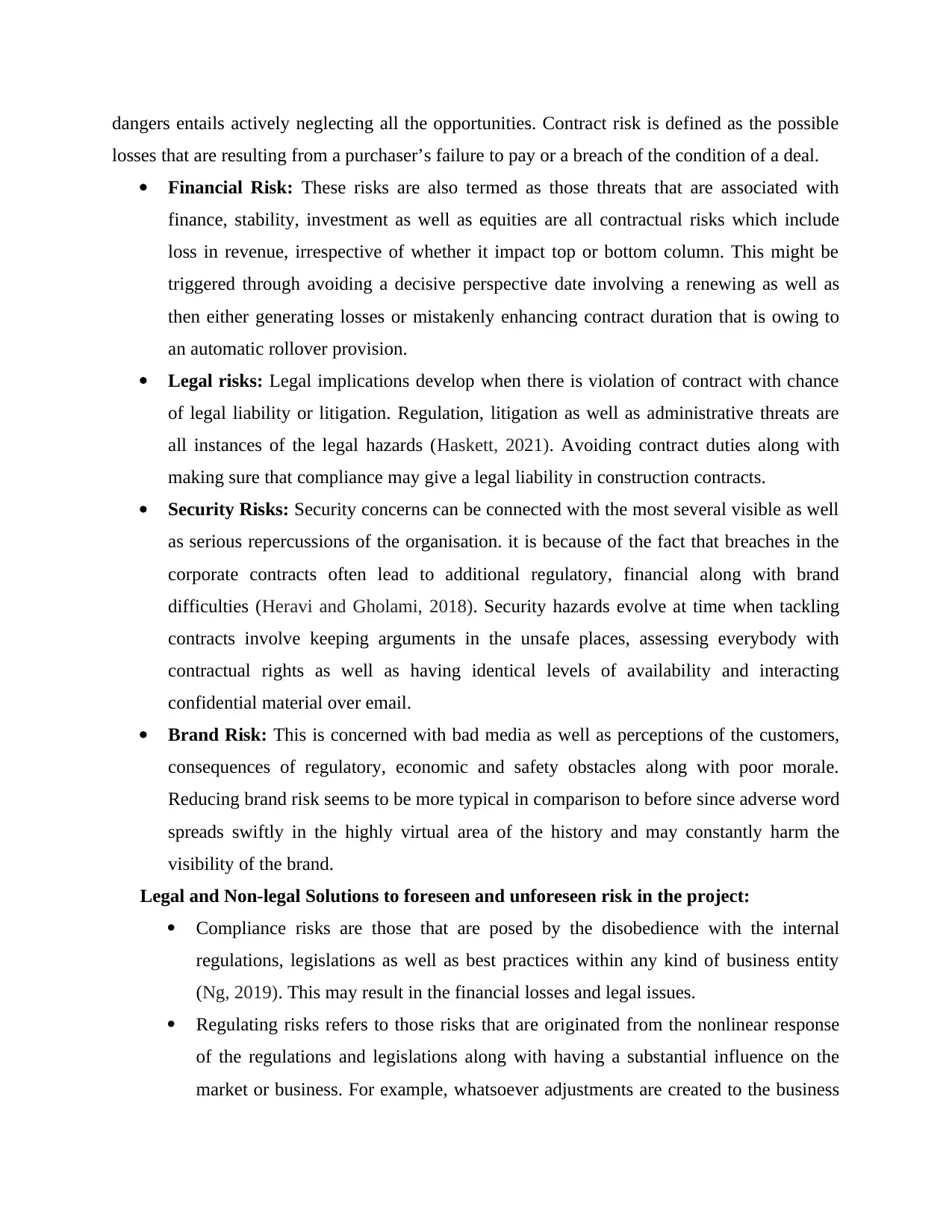
dangers entails actively neglecting all the opportunities. Contract risk is defined as the possible
losses that are resulting from a purchaser’s failure to pay or a breach of the condition of a deal.
Financial Risk: These risks are also termed as those threats that are associated with
finance, stability, investment as well as equities are all contractual risks which include
loss in revenue, irrespective of whether it impact top or bottom column. This might be
triggered through avoiding a decisive perspective date involving a renewing as well as
then either generating losses or mistakenly enhancing contract duration that is owing to
an automatic rollover provision.
Legal risks: Legal implications develop when there is violation of contract with chance
of legal liability or litigation. Regulation, litigation as well as administrative threats are
all instances of the legal hazards (Haskett, 2021). Avoiding contract duties along with
making sure that compliance may give a legal liability in construction contracts.
Security Risks: Security concerns can be connected with the most several visible as well
as serious repercussions of the organisation. it is because of the fact that breaches in the
corporate contracts often lead to additional regulatory, financial along with brand
difficulties (Heravi and Gholami, 2018). Security hazards evolve at time when tackling
contracts involve keeping arguments in the unsafe places, assessing everybody with
contractual rights as well as having identical levels of availability and interacting
confidential material over email.
Brand Risk: This is concerned with bad media as well as perceptions of the customers,
consequences of regulatory, economic and safety obstacles along with poor morale.
Reducing brand risk seems to be more typical in comparison to before since adverse word
spreads swiftly in the highly virtual area of the history and may constantly harm the
visibility of the brand.
Legal and Non-legal Solutions to foreseen and unforeseen risk in the project:
Compliance risks are those that are posed by the disobedience with the internal
regulations, legislations as well as best practices within any kind of business entity
(Ng, 2019). This may result in the financial losses and legal issues.
Regulating risks refers to those risks that are originated from the nonlinear response
of the regulations and legislations along with having a substantial influence on the
market or business. For example, whatsoever adjustments are created to the business
losses that are resulting from a purchaser’s failure to pay or a breach of the condition of a deal.
Financial Risk: These risks are also termed as those threats that are associated with
finance, stability, investment as well as equities are all contractual risks which include
loss in revenue, irrespective of whether it impact top or bottom column. This might be
triggered through avoiding a decisive perspective date involving a renewing as well as
then either generating losses or mistakenly enhancing contract duration that is owing to
an automatic rollover provision.
Legal risks: Legal implications develop when there is violation of contract with chance
of legal liability or litigation. Regulation, litigation as well as administrative threats are
all instances of the legal hazards (Haskett, 2021). Avoiding contract duties along with
making sure that compliance may give a legal liability in construction contracts.
Security Risks: Security concerns can be connected with the most several visible as well
as serious repercussions of the organisation. it is because of the fact that breaches in the
corporate contracts often lead to additional regulatory, financial along with brand
difficulties (Heravi and Gholami, 2018). Security hazards evolve at time when tackling
contracts involve keeping arguments in the unsafe places, assessing everybody with
contractual rights as well as having identical levels of availability and interacting
confidential material over email.
Brand Risk: This is concerned with bad media as well as perceptions of the customers,
consequences of regulatory, economic and safety obstacles along with poor morale.
Reducing brand risk seems to be more typical in comparison to before since adverse word
spreads swiftly in the highly virtual area of the history and may constantly harm the
visibility of the brand.
Legal and Non-legal Solutions to foreseen and unforeseen risk in the project:
Compliance risks are those that are posed by the disobedience with the internal
regulations, legislations as well as best practices within any kind of business entity
(Ng, 2019). This may result in the financial losses and legal issues.
Regulating risks refers to those risks that are originated from the nonlinear response
of the regulations and legislations along with having a substantial influence on the
market or business. For example, whatsoever adjustments are created to the business
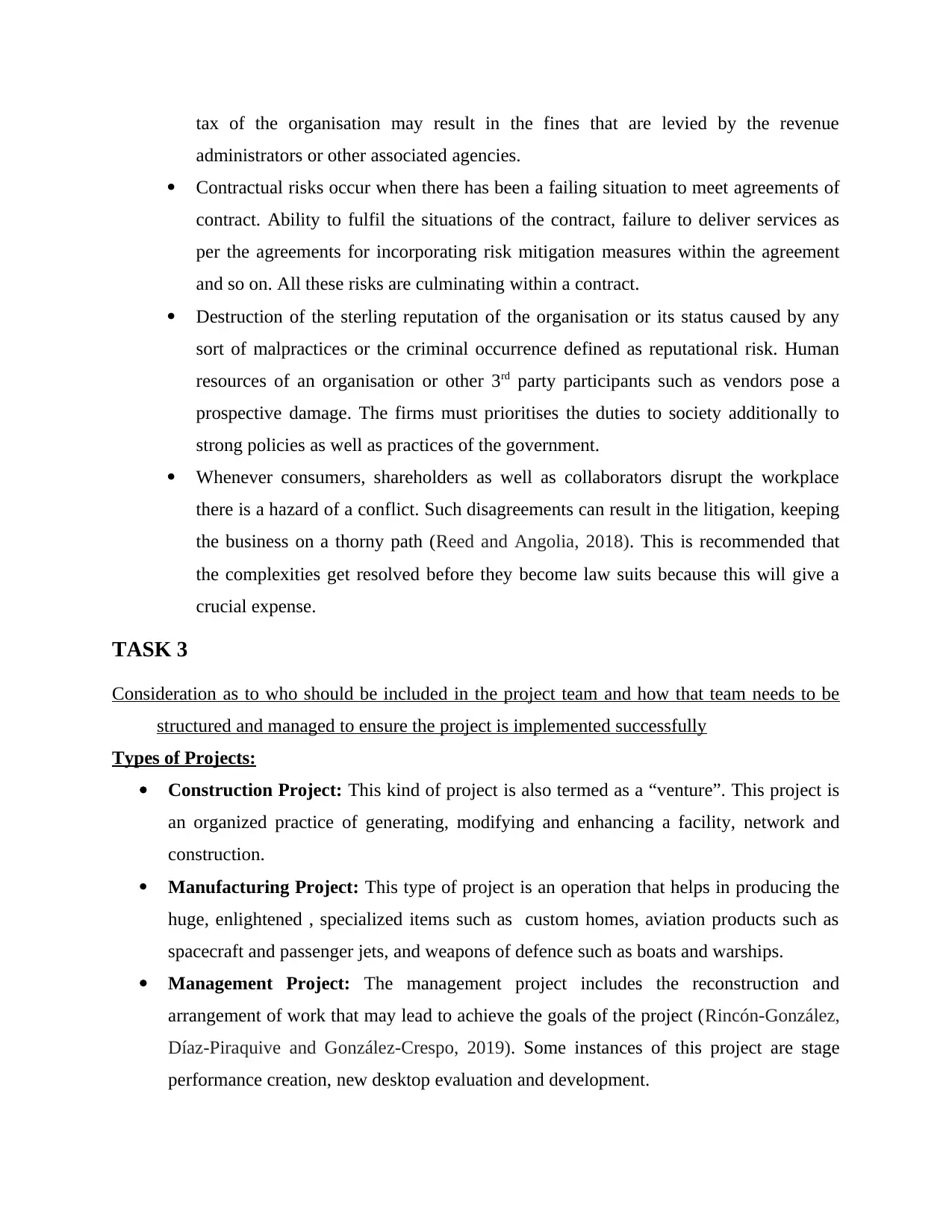
tax of the organisation may result in the fines that are levied by the revenue
administrators or other associated agencies.
Contractual risks occur when there has been a failing situation to meet agreements of
contract. Ability to fulfil the situations of the contract, failure to deliver services as
per the agreements for incorporating risk mitigation measures within the agreement
and so on. All these risks are culminating within a contract.
Destruction of the sterling reputation of the organisation or its status caused by any
sort of malpractices or the criminal occurrence defined as reputational risk. Human
resources of an organisation or other 3rd party participants such as vendors pose a
prospective damage. The firms must prioritises the duties to society additionally to
strong policies as well as practices of the government.
Whenever consumers, shareholders as well as collaborators disrupt the workplace
there is a hazard of a conflict. Such disagreements can result in the litigation, keeping
the business on a thorny path (Reed and Angolia, 2018). This is recommended that
the complexities get resolved before they become law suits because this will give a
crucial expense.
TASK 3
Consideration as to who should be included in the project team and how that team needs to be
structured and managed to ensure the project is implemented successfully
Types of Projects:
Construction Project: This kind of project is also termed as a “venture”. This project is
an organized practice of generating, modifying and enhancing a facility, network and
construction.
Manufacturing Project: This type of project is an operation that helps in producing the
huge, enlightened , specialized items such as custom homes, aviation products such as
spacecraft and passenger jets, and weapons of defence such as boats and warships.
Management Project: The management project includes the reconstruction and
arrangement of work that may lead to achieve the goals of the project (Rincón-González,
Díaz-Piraquive and González-Crespo, 2019). Some instances of this project are stage
performance creation, new desktop evaluation and development.
administrators or other associated agencies.
Contractual risks occur when there has been a failing situation to meet agreements of
contract. Ability to fulfil the situations of the contract, failure to deliver services as
per the agreements for incorporating risk mitigation measures within the agreement
and so on. All these risks are culminating within a contract.
Destruction of the sterling reputation of the organisation or its status caused by any
sort of malpractices or the criminal occurrence defined as reputational risk. Human
resources of an organisation or other 3rd party participants such as vendors pose a
prospective damage. The firms must prioritises the duties to society additionally to
strong policies as well as practices of the government.
Whenever consumers, shareholders as well as collaborators disrupt the workplace
there is a hazard of a conflict. Such disagreements can result in the litigation, keeping
the business on a thorny path (Reed and Angolia, 2018). This is recommended that
the complexities get resolved before they become law suits because this will give a
crucial expense.
TASK 3
Consideration as to who should be included in the project team and how that team needs to be
structured and managed to ensure the project is implemented successfully
Types of Projects:
Construction Project: This kind of project is also termed as a “venture”. This project is
an organized practice of generating, modifying and enhancing a facility, network and
construction.
Manufacturing Project: This type of project is an operation that helps in producing the
huge, enlightened , specialized items such as custom homes, aviation products such as
spacecraft and passenger jets, and weapons of defence such as boats and warships.
Management Project: The management project includes the reconstruction and
arrangement of work that may lead to achieve the goals of the project (Rincón-González,
Díaz-Piraquive and González-Crespo, 2019). Some instances of this project are stage
performance creation, new desktop evaluation and development.
⊘ This is a preview!⊘
Do you want full access?
Subscribe today to unlock all pages.

Trusted by 1+ million students worldwide
1 out of 16
Related Documents
Your All-in-One AI-Powered Toolkit for Academic Success.
+13062052269
info@desklib.com
Available 24*7 on WhatsApp / Email
![[object Object]](/_next/static/media/star-bottom.7253800d.svg)
Unlock your academic potential
Copyright © 2020–2026 A2Z Services. All Rights Reserved. Developed and managed by ZUCOL.
